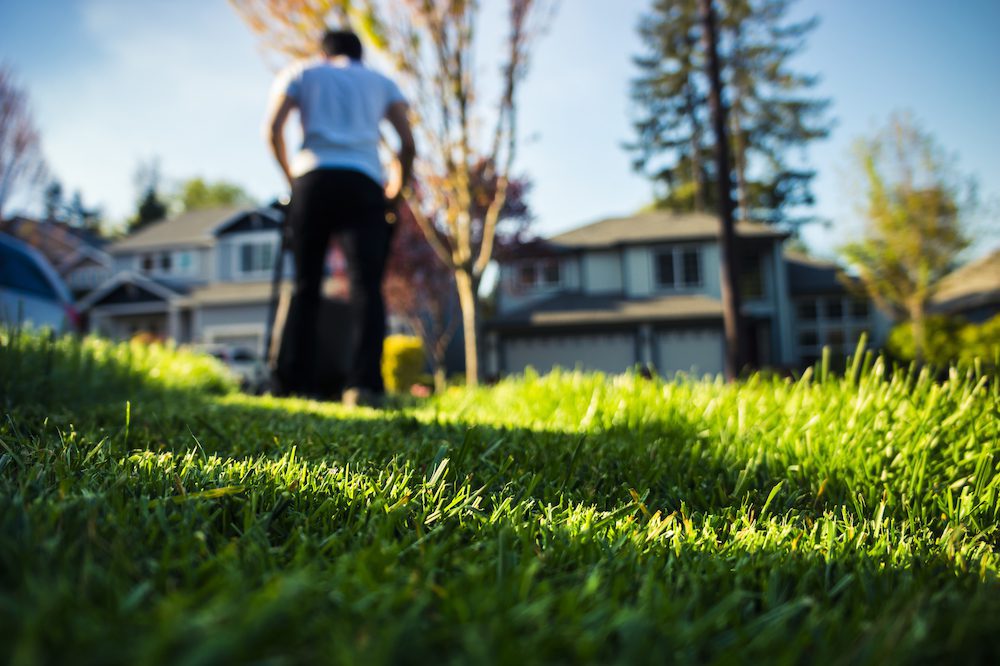Aeration is a proven way to improve the health and beauty of your lawn. But how often should you aerate your lawn, and how exactly does it work?
Learn about how aeration works, how often to aerate, and how to do it right so your lawn is the greenest on the block all year long.
What Is Aeration?
Technically, aeration is the exchange process between your lawn’s soil and the surrounding atmosphere. Aeration occurs naturally, and allows the soil of your lawn to soak in oxygen, which allows for deep, healthy turf roots to grow.
Mechanically, aeration (or core aeration) refers to removing small plugs of thatch layer and soil from your lawn to improve the natural aeration process. Increased access to air, water and fertilizer means your turf grass roots can grow deeper, allowing your lawn to look lush and uniform for the spring and summer.
Plus, core aeration won’t affect your herbicide barrier, meaning it won’t hinder your weed-prevention efforts.
Do you have a weed problem? Learn about four weeds you need to take care of immediately >
Benefits of Aeration
Core aeration helps enrich the overall health of your lawn’s soil in handful of ways, including:
- Increases the root zone of your lawn’s access to air, water and fertilizer
- Introduces thatch-decomposing microorganisms from the soil to the thatch layer — thatch prevents the roots of your lawn from growing deep into the soil and makes your lawn more prone to disease, insects and winter kill
- Relieves soil compaction and decreases soil density, allowing for proper aeration
- Enhances seed-to-soil contact necessary for grass germination
- Supports seedling development by creating a moist environment that enriches root growth
When to Aerate: Grass and Soil Type
The key to timing your aeration is based on the type of grass in your lawn: warm-season or cool-season grass. Rapid growth helps the lawn quickly recover from the stress of aeration, so timing your aeration to coincide with the growth period of your grass will ensure your lawn can quickly fill in the holes you create.
Late spring and early summer are excellent times to core aerate warm-season grasses, especially before and after seeding an existing lawn. Cool-season turf emerges in early fall and grows rapidly once temperatures drop and weed competition is reduced.
Pro tip: Don’t wait too long to aerate cool-season turf — try to allow four weeks of growth between aeration and the first frost.
Soil type is a determining factor for how frequently you should aerate your lawn. In arid climates, such as here in Colorado, aerating twice a year can enhance turf growth and health. Clay soil compacts easily, and should be aerated at least once a year. If you park cars on your lawn, aerating annually will help lessen damage to the lawn.
Pro tip: Avoid aerating during a drought or periods of high heat. Hot, dry conditions are stressful for turf root growth.
How to Aerate Your Lawn
- Rent or buy a spike aerator or plug aerator to core aerate your lawn.
- The best time to aerate is the day after a good rain shower or shortly after you’ve watered your lawn (soil should be moist but not saturated — wet soil clogs tines). Dry soil takes a lot more effort to plug.
- Most aeration machines cover only a small percentage of soil surface per pass, so you’ll probably need to make several passes over the most compact areas of your lawn.
- Allow the excavated soil plugs to dry, and then break them up to give your lawn a clean, polished appearance. You can break up aeration plugs by running them over with a lawn mower or pounding them with the back of a rake.
- After aerating, continue your basic lawn care regimen. Fertilizing, mowing and watering will all support the effectiveness of the aeration process.
- Applying lime or sulphur to your lawn after core aeration modifies the pH profile of the soil, which in turn allows nutrients to work their way deep into the root zone.
When It’s Time to Leave Lawn Aeration to the Pros
Aeration requires a lot of time and effort — especially if you have a large lawn, and/or live in regions like the Mountain West where the top layer of soil is typically dry and compact due to year-round sunshine. Plus, breaking up the plugs after you aerate may necessitate sharpening your lawn mower blade (or icing your back if you choose to use a shovel!)


